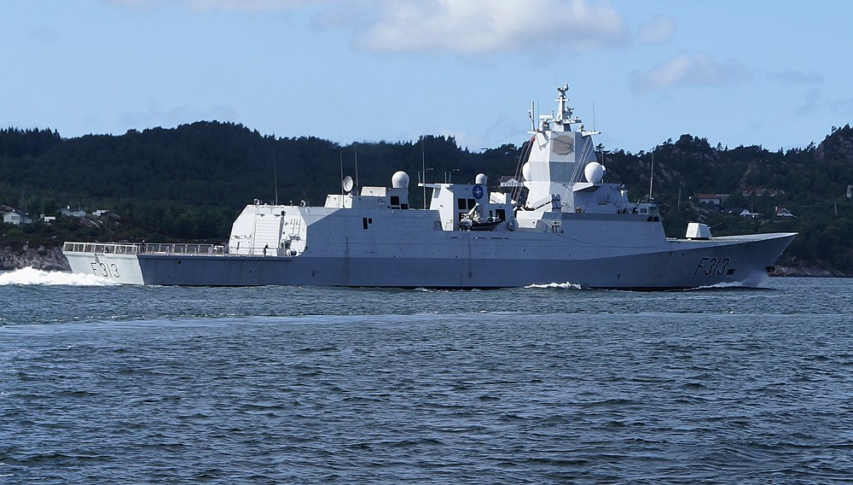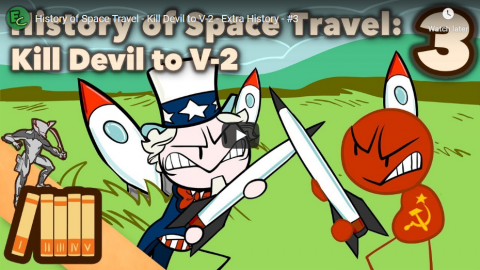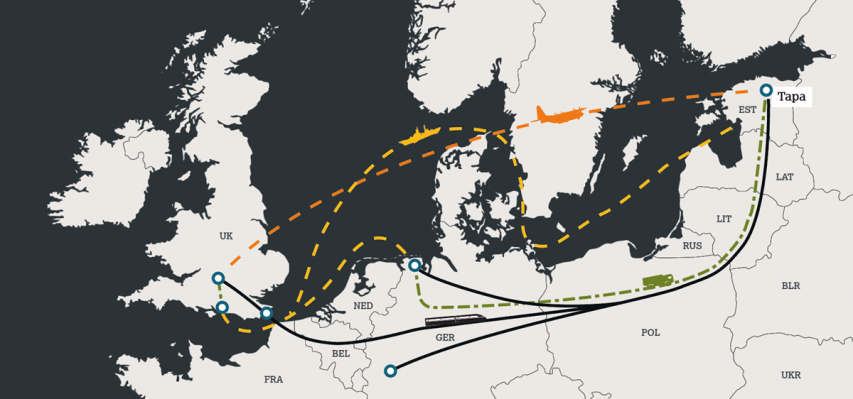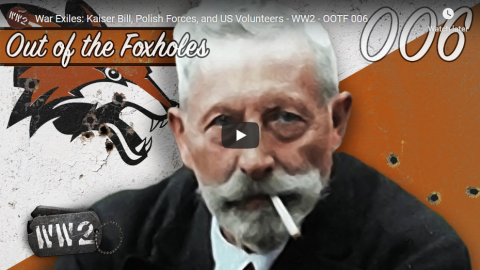Extra Credits
Published 14 Nov 2019Start your Warframe journey now and prepare to face your personal nemesis, the Kuva Lich — an enemy that only grows stronger with every defeat. Take down this deadly foe, then get ready to take flight in Empyrean! Coming soon! http://bit.ly/EHWarframe
Early flight started as a utopian dream but quickly became the military’s top priority: first as reconnaissance vehicles, and then as weapons in their own right. After WW1, the threat of German aircraft led to the Treaty of Versailles banning Germany from having an airforce at all. But the Germans also found a loophole: rockets didn’t count as an airforce. Enter Werner Von Braun & the V-2 rockets.
November 16, 2019
History of Space Travel – Kill Devil to V-2 – Extra History – #3
The British army’s “Tractable” shows the continued importance of logistics
Sir Humphrey discusses the ongoing commitment of nearly a thousand British soldiers to Estonia, and how the logistics to get them and their equipment there illustrates a rarely discussed but critical military capability:
One of the most significant exercise commitments this year has been the British Army and “Tractable” (sometimes referred to as either “Op” or “Exercise” but without a title on the British Army website. This major undertaking has been running for some weeks now and has highlighted how the British Army continues to excel at undertaking large scale movements of units in order to be ready to conduct operations as required.
The genesis of Tractable was the need to rotate assets out of Estonia and send new vehicles from the UK in their place. It is often overlooked that the UK now has over 900 British Army personnel permanently stationed in Estonia as part of wider NATO work to help send a strong signal to deter aggression from nations like Russia – which given its recent history of attacking and invading other countries and acting in a remarkably uncivilised manner is certainly required.
[…]
This may sound an obvious and straightforward thing to say, but investment in logistical tail is rarely something that features in many peoples “fantasy Army ORBAT” threads that litter the internet. Most people focus on combat power, looking at how many tanks or self propelled guns an Army has and then considering what this means for its combat power from there.
For the British Army, the investment in heavy armour, APCs and artillery is important, but equally so is the important in assets like logistics enablers – the ability to lift by train or sealift in order to actually get the Army where it needs to be, and not stuck somewhere irrelevant. The purpose of Tractable has as much been to test that the Army can still do this well, and that the various enablers work as intended to deliver a force that can fight.
In practical terms this has meant a focus on areas that often get relatively little attention. For example the skills required to pull vehicles out of storage, conduct road and rail moves across Europe and then deliver them to Estonia are complex and perishable. There is a lot of work required to ensure that a train can be safely loaded with the right armoured vehicles and then sent through the Channel Tunnel for onwards travel.
This work often puts significant responsibility in the hands of very junior soldiers who are responsible for ensuring that millions of pounds of equipment is safely handled and put in place properly. One slip up could have huge consequences and potentially cost lives as well. It is only by practising this activity regularly that it can be done safely and effectively for real though.
In the case of Tractable what it has demonstrated is the critical importance of the Royal Logistics Corp to the wider British Army. While logistics may not be a supremely “sexy” subject to many people, being able to ensure that the Army has the right equipment, people and training to be able to do this sort of work is essential – without it, things would rapidly grind to a halt.
Similarly, Tractable has helped focus attention on other critical capabilities like strategic sealift. The use of the “POINT” class strat ro-ro ferry force to help move vehicles across the channel and into Emden (and then onto Estonia) has helped show how key these vessels are to British Army capability. Without them it would be much harder to do the complex business of deploying overseas. Here too we are also reminded of the critical importance of units like 17 Port and Maritime Regiment, one of the most unusual (and vital) units in the Army today, responsible for co-ordinating the sealift and deployment of vehicles around the globe.
War Exiles: Kaiser Bill, Polish Forces, and US Volunteers – WW2 – OOTF 006
World War Two
Published 14 Nov 2019What happened to Kaiser Wilhelm II after World War One? How did Polish soldiers flee to Allied territories after the 1939 invasion? And did any American volunteers serve in the war in 1939 and 1940? We answer all of this in this episode of Out of the Foxholes.
Join us on Patreon: https://www.patreon.com/TimeGhostHistory
Or join The TimeGhost Army directly at: https://timeghost.tvFollow WW2 day by day on Instagram @World_war_two_realtime https://www.instagram.com/world_war_t…
Join our Discord Server: https://discord.gg/D6D2aYN.
Between 2 Wars: https://www.youtube.com/playlist?list…
Source list: http://bit.ly/WW2sourcesHosted by: Indy Neidell
Produced and Directed by: Spartacus Olsson and Astrid Deinhard
Executive Producers: Bodo Rittenauer, Astrid Deinhard, Indy Neidell, Spartacus Olsson
Creative Producer: Joram Appel
Post Production Director: Wieke Kapteijns
Research by: Rune Vaever Hartvig
Edited by: Mikołaj Cackowski
Map animations: EastoryEastory’s channel: https://www.youtube.com/channel/UCEly…
Archive by Screenocean/Reuters https://www.screenocean.com.A TimeGhost chronological documentary produced by OnLion Entertainment GmbH.
From the comments:
World War Two
2 days ago (edited)
We get a ton of questions about the war on a daily basis. A lot of them are already answered in the YouTube comments to you all directly, but because some questions are very interesting indeed, we like to showcase some of them on the channel. Because the YouTube comments are hard to navigate, we have made a section on our forum where you can submit questions to be covered in Out of the Foxholes. You can do that here: https://community.timeghost.tv/c/Out-of-the-Foxholes-QsCheers,
The TimeGhost team
Report on the collision that sank HNoMS Helge Ingstad last year
The Norwegian frigate HNoMS Helge Ingstad was eventually declared a total loss due to the damage from the collision and the resulting water damage as the ship sank near the Sture Terminal in November 2018. The first part of the report on the accident has been released:

HNoMS Helge Ingstad, a Fridtjof Nansen-class frigate commissioned in 2009.
Photo detail via Wikimedia Commons.
The frigate HNoMS Helge Ingstad and the tanker Sola TS collided in the Hjeltefjord in the early hours of 8 November 2018. The frigate had 137 persons on board with a mix of conscripts and permanent crew. A total of seven watchstanding personnel were present on the bridge, including two trainees. The tanker Sola TS was operated by the Greek shipping company Tsakos Columbia Shipmanagement (TCM) S.A. There was a total of 24 persons on board. The bridge was manned by four persons, including the pilot.
HNoMS Helge Ingstad sailed south at a speed of approximately 17–18 knots with the automatic identification system (AIS) in passive mode, i.e. no transmission of AIS-signal. The frigate’s bridge team had notified Fedje Vessel Traffic Service (VTS) of entering the area and followed the reported voyage. Sola TS had been loaded with crude oil at the Sture Terminal, and notified Fedje VTS of departure from the terminal. Sola TS exhibited navigation lights. In addition some of the deck lights were turned on to light up the deck for the crew who were securing equipment etc. for the passage.
In advance of the collision, Fedje VTS had not followed the frigate’s passage south through the Hjeltefjord. The crew and pilot on Sola TS had observed HNoMS Helge Ingstad and tried to warn of the danger and prevent a collision. The crew on HNoMS Helge Ingstad did not realise that they were on collision course until it was too late.
At 04:01:15, HNoMS Helge Ingstad collided with the tanker Sola TS. The first point of impact was Sola TS‘ starboard anchor and the area just in front of HNoMS Helge Ingstad‘s starboard torpedo magazine.
HNoMS Helge Ingstad suffered extensive damage along the starboard side. Seven crew members sustained minor physical injuries. Sola TS received minor damages and none of the crew were injured. Marine gas oil leaked out into the Hjeltefjord. The Institute of Marine Research has ascertained the effect of the oil spill had little impact on the marine environment.

HNoMS Helge Ingstad after grounding, 13 November 2018. Due to the steep nature of the seabed at the shoreline, the frigate slid down until it was almost totally underwater after initial grounding.
Photo via The Drive.
There is an embedded video with the report that neatly summarizes the series of events leading up to the collision.
Funny English Idioms – and why we say them!
Joolz Guides – London History Walks – Travel Films
Published 7 Jan 2018Funny English Idioms – and why we say them!
English people use some funny idioms and expressions. We love them, especially if they are about going to the toilet!
Subscribe on Youtube ➜ https://www.youtube.com/joolzguides
Joolz Guides website to book a private tour ➜ http://joolzguides.com/
Julian McDonnell, that’s me, runs a London vlog and youtube channel where he talks about all things to do with London which you may not have known. This includes language and the way English people speak. Amongst many other funny idioms for going to the toilet one of the oldest ones is “To Spend a Penny”. This came about because it used to cost one penny to go to the public lavatories when they first appeared on the streets in 1851!
Hopefully this video will help you to understand the origins of these funny English idioms and expressions and help you to learn English or they may even be helpful if you are an ESL teacher or TEFL.
Another funny English idiom is when we say “He was sent to Coventry”. This indicates somebody who has been ostrasized and no one wants to talk to. Watch the video to find out how this came about.
Did you ever hear someone use the idiom “To hear a pin drop”? This actually originates from the tea auctions where you were only allowed to bid for a certain amount of time. They put a pin into a candle and let it burn down. When the pin fell out if there were no more bids you could hear a pin drop!
Our fourth funny idiom is a baker’s dozen. Anyone will tell you that a dozen is 12 but a baker’s dozen is 13! This is because in 1266 there was a law that would penalise bakers if they sold less than they said they were selling! So to make sure they weren’t short of their weight they would add a thirteenth loaf just to make sure.
Then comes our final idiom – To be on the wagon.
This means that someone is not drinking alcohol and it originates from the days when criminals would be hanged. They would stop at the Resurrection Gate pub and be bought one last drink but after that drink they had to get back onto the wagon and couldn’t drink any more. Then the wagon would take them to the gallows.
To make it more fun I have tried to show some of the locations which would have been affected by these expressions as well as point out some interesting historical facts which are related to them.
I go to Twinings in The Strand, The Royal Exchange, Pudding Lane and St Giles in the Fields
SUPPORT MY CHANNEL ON PATREON ➜ https://www.patreon.com/joolzguides
DONATE TO MY CHANNEL WITH PAYPAL ➜ https://www.paypal.me/julianmcdonnell
QotD: Millennials as barbarians invading our civilization
Hannah Arendt is said to have remarked that civilization is always being invaded by barbarians we call “children.” I don’t like to put a dangerously hard-to-trace quotation in the newspaper, but I first heard this half-jest decades ago and its depth has only impressed me more every year. Whoever said it first was obviously pretty learned and subtle, even if it wasn’t Arendt. “Barbarians” is a Greek word for incomprehensible, gibberish-spewing foreigners, but one of the great discoveries of the Greeks is that of the barbarians’ point of view, and the additional idea that this point of view deserved equal esteem.
Every nation believes its own customs and habits are the best, Herodotus said, and you would have to be nuts to dismiss those prejudices as though they were somehow objectively wrong. (I grant that this is a free translation, but he said it, and it is one of the intellectual breakthroughs with which we associate the Greeks.) As with nations, so it is with generations. The formative experiences, inherited expectations, and learned fears of somebody born in 1985 are hardly less different from mine than a foreigner’s would be.
If I say that my attitude toward millennials is that they are barbarians, I am asking for trouble, but I must insist on being understood: it is only that they are persons whose habits, prejudices, and values are foreign, formed by a different set of events and influences — not that they are inferior. In the right mood I can even be persuaded that their actual knowledge is simply of a qualitatively different character, rather than simply being more meagre because they have lived less long.
Colby Cosh, “‘Millennial’ gets used as an insult. But millennials aren’t actually inferior”, National Post, 2017-10-25.







